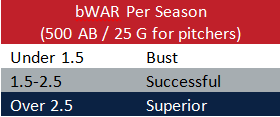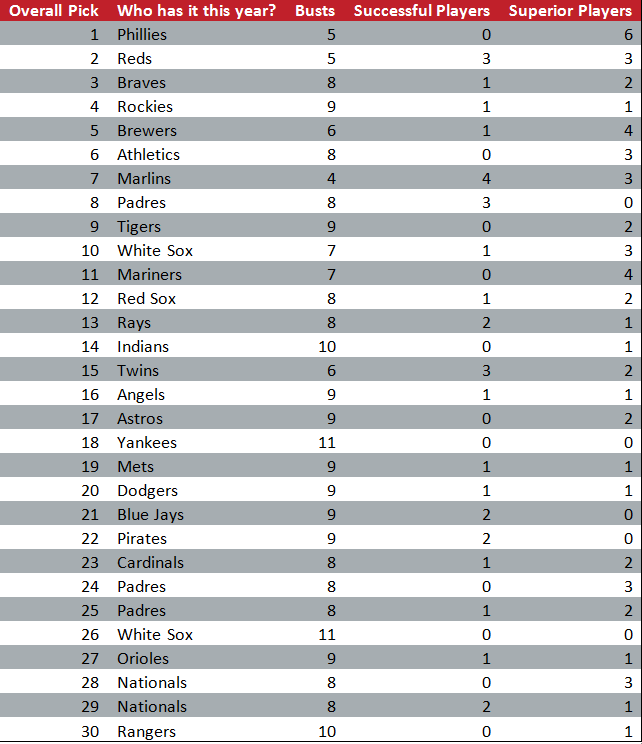The MLB Rule 4 amateur draft was last week and fans will clamor for any sort of information regarding their team’s new, shiny, sometimes 18-year old future stars. The draft gives fans a chance to dream on what will be in seasons to come, each team’s fans are hoping for their very own Mike Trout. But for every Mike Trout, there are plenty of players like Hank Congers or Zack Cox who were also selected at pick number 25 and who aren’t exactly rewriting the record books.
In doing research for my latest post on the awful Jim Bowden, I found a concerning lack of recent research on draft success. We have plenty of anecdotes, and plenty of information on top prospects busting, but very little in the way of what to expect from a team’s first-round draft pick. I found a good piece from 2012 from The View from the Bleachers on Success Rate of MLB Draft Picks by Slot and referenced that, but there’s definitely more here.
There have been nine drafts since the last draft referenced in that post. Scouting, sabermetrics, and our general collective baseball knowledge feels like it has been increasing exponentially in that time. Does draft success bear that out? Well, not exactly.
The first thing to set up here is to establish a “successful” player. I pondered it for a minute and settled on basically the same approach that Michael used way back in 2012. If the player hasn’t made the majors, or if they had a WAR of less than 1.5 when they got there, that first rounder is a bust automatically. These players might be useful, but hardly the type that an organization should target in the first round. With that in mind, I established a simple calculation to assign a players success.
I likely should have built in a separate “World’s Best” category for those players who are averaging 8+ WAR. Oh, that’s just Trout, OK.
The calculation feels like it makes sense on an anecdotal level, too. Eric Hosmer, Yonder Alonso, and Wade Miley are labeled successful, but not superior. That feels right. These guys aren’t changing an organization. They’re good major league players, but not great.
The trick comes in assigning busts, especially when considering players from more modern drafts. Jameson Taillon has yet to achieve the mandatory 1.5 WAR, but he’s hardly a bust just yet. And what do we do with guys like Billy Butler? He’s officially a bust by my calculation, but that doesn’t feel quite right. Huston Street, James Loney, and Garrett Richards are all also busts. Ike Davis, and Pedro Alvarez, too. But the formulas are sound. A successful major leaguer should be able to produce 1.5 WAR per season. In 2015, Chase Headley, Nick Markakis, and Alcides Escobar all hit that threshold. It shouldn’t be too much to expect a first rounder to perform at that level.
Besides, this is baseball and statistics. There’s no crying in baseball or statistics.
To the results!
First, how many of 1st rounders actually make the majors? That feels like some basic threshold of success. Is your organization capable of selecting a player in the first round that actually makes his way to the majors?
A few things jump out from the chart above. Of the 55 players selected in the top 5 between 2000 and 2010, 48 reached the major leagues. That seems like a really good rate. Teams were able to more or less successfully identify the best 5 players available in a given draft. Of course, there’s probably some bias here as teams are more likely to promote players they took at the very top of the draft to save face, even if they might not be perfectly qualified.
The pattern pretty much holds for the rest of the first round too. There’s more uncertainty as you get later and later in the draft but scouts seem to hit more than they miss. That’s a pretty low bar though. You would hope that scouts would be a bit better than 32/55 (58%) on picks 26-30, considering that there are hundreds and hundreds of players chosen.
Next, let’s look at the chance to find a successful player, as we defined it earlier, in the first round of the draft.
 That’s pretty low. Our definition of a successful player was pretty narrow, to be sure, but it seems like 1.5 -2.5 WAR guys should be pretty prevalent. Guess not. Let’s see how front offices do on picking up superior players.
That’s pretty low. Our definition of a successful player was pretty narrow, to be sure, but it seems like 1.5 -2.5 WAR guys should be pretty prevalent. Guess not. Let’s see how front offices do on picking up superior players.
Pretty well actually! Superior players should be pretty rare, at least if we set the criteria correctly, but more than a quarter of top 5 picks are in that category. That seems pretty good.
I’m starting to wrap my head around a theory, let’s see if this next chart bears it out….
Ok; here’s what I’ve got. It’s more likely than not that a first round selection will be a bust. If he’s not a bust though, it’s more likely than not that he’ll be a superior player. It seems like the chances of a first rounder being merely successful – just a decent big league player – are actually pretty small.
A reasonable conclusion then, is that scouts go for the proverbial home run in first round selections. They take a bit more risk in order to try and unearth a truly unique talent. They then aim to fill out their system with more average players in the later rounds.
My research gives fans and scouts all the more reason to dream on their first round picks today.
A last little bit of fun. For the draft last week, I wanted to point out which organizations were selecting in a spot that may not yield quite the results that they want. Yankees and White Sox fans, shield your eyes.
So before you go getting all excited about the draft picks from last week, keep in mind that a majority of them are simply going to be busts. The one’s that aren’t though, they’ll probably be stars.
-Sean Morash
This post originally ran over at Fangraphs, but we thought it was good so you should enjoy it here, too.





















